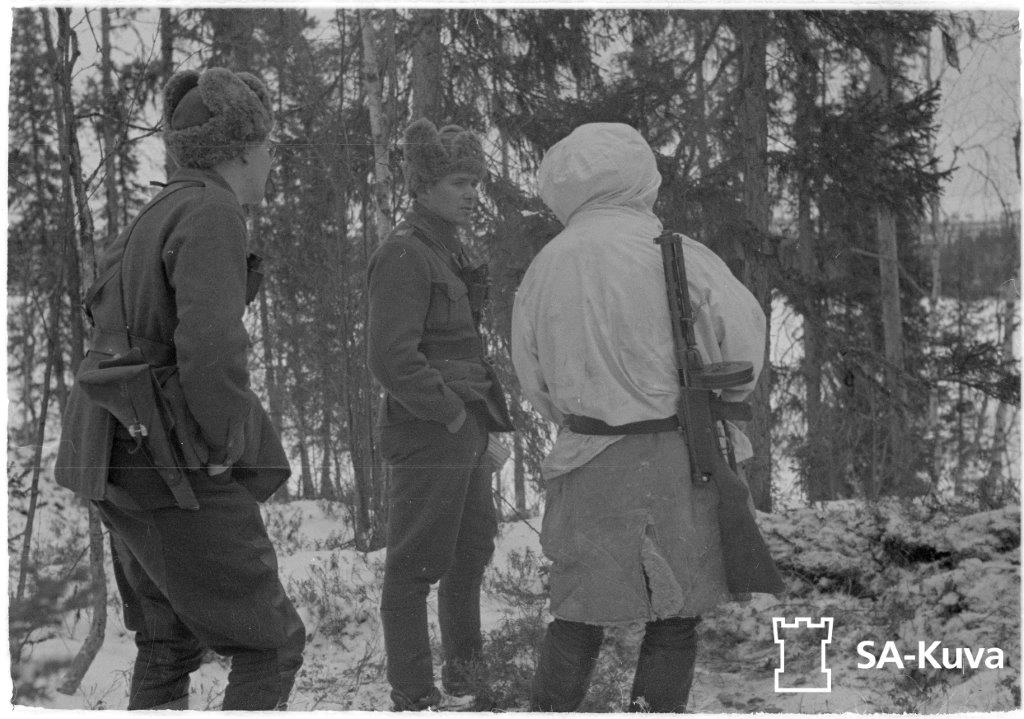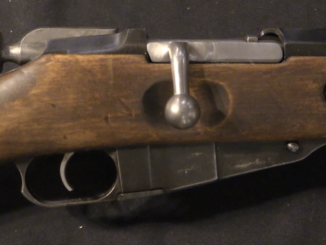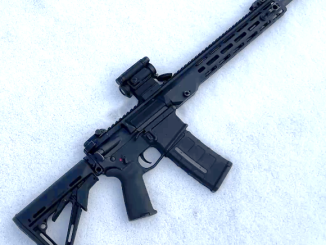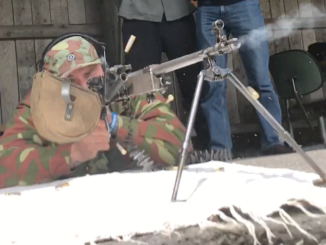
Vertical forward grip? Check.
Shoulder thing that goes up? Check.
Drum magazine? Check.
All it needs is a laser sight!
Finnish soldiers, photo found by Leszek at the Finnish Winter War Archive. The fellow on the left has a holstered Lahti L35 pistol, while the gent on the right has an early Suomi m/31 SMG.




Interesting position for a foregrip on the m/31 SMG. It appears to be well aft of the center of balance, so using it would probably have made the gun feel front-heavy.
Very CSRG 1915-like. Although nowhere near as hilariously bad.
I’m still trying to wrap my head around how in the 30’s they thought that submachine guns could act as light machine guns (hence the bipod and quick-change barrel). At the time when they wanted to make sure that rifles could accurately hit people at further than my (admittedly bad) eyes can even make out a person, they thought that a machine gun could be in a pistol cartridge. With the Villar-Perosa it’s understandable because of how early it is, but by 1931 one would have thought the experience of the MP18 and the M1921/1928 Thompsons would have given some lessons as to what SMGs can do. Nor was it like there wasn’t true LMGs – by that point you’ve even got the ZB 26 and MG 30. I know hindsight is 20/20 (again, much better than my real sight), but that seems like that should have been fairly obvious.
Agreed — you brought up some salient points on the topic. When one looks closely at the manufacturers’ stated effective ranges for typical SMG’s in the 1930’s and 1940’s, 200m-300m is most often quoted, and this from weapons with short barrels less than 10″ long and firing pistol cartridges. This is certainly entirely feasible under perfect, stable conditions at a firing range. While even a relatively low-velocity round of this type will still do serious damage against a soft target at those ranges, when one takes into account all the other ballistic and mechanical factors involved in using an SMG with iron sights, actually hitting said target under battlefield conditions is a much more difficult proposition. However, the m/31 had a longer barrel ( 12.4″ ) which greatly enhanced accuracy at extended ranges, and the bipod would have been a big help in this. Even so, the Finns found the m/31 wanting in the LMG role and ended up, via experimentation, determining that a high-low mix of a captured DP or equivalent LMG backed by one ( pre-1943 ) or two ( 1943 onwards ) m/31’s in the average infantry squad was about ideal for their purposes.
As far as the Villar-Perosa was concerned, the main customer at the time, the Alpini, considered the gun suitable for their specialized needs because of its compactness, portability, close-range automatic firepower, and the fact that mountain warfare usually involved much closer ranges anyway.
You could found the Vertical forward grip in many SMG of this time
* Sten MK1 (folding Vertical forward grip)
* Erma Volmer EMP35 (German, French & Spanish version) : http://i225.photobucket.com/albums/dd297/armeiro1/groupe_franc__08.jpg
* STEN MKV
* AUSTEN MK1 : http://en.wikipedia.org/wiki/File:Austen_Mk1_9-mm_submachine_gun.jpg
* GNOME & RHÔNE R5 (French STEN Clone with feathure of the MKII & MKII) : http://www.tircollection.com/t4369-un-pm-meconnule-r5-gnome-rhone
Those were excellent examples of SMG’s with foregrips, among many others. Even the venerable M1928 Thompson .45-cal. SMG featured a foregrip in its early variants. Not too many, however, had the foregrip located aft of the magazine well ( the EMP35 you mentioned was one of the few ), and even fewer had it mounted so far aft of the probable center of balance. The Finns are a highly practical and logical people who excel in disciplines such as engineering and technology, so there may have been a very specific reason for locating the foregrip on the m/31 in that position. Any ideas, anyone?
My guess would be for two handed controll specifically when using the tall, front-mounted bipod. Two hands = better “steering” from the rear..
And Polish Mors wz.39 as well
I am personally not familiar with the Lahti L35 pistol, although I’ve read up to some extent about it. Has anyone on FW handled or used the L35? It would be interesting to hear more about the L35 directly from a user’s standpoint.
The Finnish L35 is pretty rare in the U.S., but Swedish Model 1940s are pretty common. I have not shot my L35, but I have shot my Model 1940s extensively. They are solid, robust, reliable pistols which seem a bit heavy when compared to their contemporaries. These pistols seem to have been designed by a machine gun designer, not a pistol designer, sort of like the German G.41 rifles.
Many people, particularly left handers, complain that the safety bites into the shooting hand during firing. Accuracy and functionality is very good, however the safety operation is really a second hand operation – not good in a combat pistol.
Trigger pulls are much heavier than the Finnish Lugers I have. The Finnish Lugers I have encountered all seem to have ‘match tuned’ triggers. It seems that this heavy, long trigger pull was deliberate, probably to avoid accidental discharges with gloves on. Fit and finish of the Finnish Lahtis is on a par with a nice Luger, the Swedish pistols show a lot of milling marks but are still pleasing. I have never experienced any broken parts while firing over 1,000 rounds through several Swedish Lahtis, but I have read of others experiencing parts breakage.
A Swedish veteran of the Winter War told me to take out the accelerator when firing Lahtis during the summertime and I have done this. He said the accelerators were only intended for winter service. This may have spared me broken parts.
Like the Finnish Lugers, the Lahtis all have good sights. Accuracy with good ammunition is on a par with a good P.38 or P.08, once you adjust to the trigger pull. Field stripping and full disassembly is straightforward, but their is an arrow on the locking block to keep you from screwing up reassembly.
All in all, a good pistol design for its time, but somewhat dated today.
Thanks for the input, John — it was quite enlightening to read your account.
The Swedish Copy of the L35, Husqvarna M40, is as far as I know prone to break mostly if using the Swedish 9mm M/39B Submachinegun round. As said, the round was designed to give more punch and range to the M/45 SMG, and wasnt fit for the Pistols. It is not uncommon to the see Swedish M40 pistols with cracks in the slide from overstressing when fireing the M39B. An uncle of mine actually got the slide in the face when it broke off while fireing. This is also one of the reasons why the M40 was put out of service with the Swedish Army – to many showed stress-fractures from fireing overpowered ammunition, and from what Ive heard, one or two soldiers lost their right eye becouse of it.
– Or at least this is what Ive been told.
The holster Shoulder stock look like Browning Highpower GP35 of the Finnish contract.
http://www.jamesdjulia.com/auctions/archived/firearms/mar01/web/393-396.jpg
The Stocked pistol onthe left appears to be a FN Browning 1935 High Power because of the bright tab to secure the flap.
Pistol is holster with wooden stock is not L-35 but FN GP-35 of FN High Power. Suomi M/31 is really intresting and rare variation – not the extra grip and lmg-like supporting “legs”.
Oops, sorry – that really is an HP, not Lahti – my bad.
RE : “Bipod? Check.
Vertical forward grip? Check.
Shoulder thing that goes up? Check.
Drum magazine? Check.
All it needs is a laser sight!”
And let’s not forget the pistol grip, 6-position adjustable folding synthetic stock, quad-rail fore-end, Mepro MOR holographic sight with integrated laser and IR illuminators, Night Force NXS 8-32 x 56 illuminated reticle AO scope, Accu-Tact Angle Sight with QD mount, 800-lumen LED light with remote pressure pad, and…….eeyargghhh!
Jeremy, I think what motivated the finns was who their enemy was. Russians didn’t much believe in fire and manuver at that time. There are documented cases during the winter war of small teams of men armed with the suomi wiping out whole battalions of ruskies. The finns REVERE the M31 Suomi for a good reason.
I’m thinking ( rightly or wrongly, perhaps ) that the fire-and-maneuver tactics of the Finnish Army also exploited the firepower advantages of the m/31 at closer ranges and may have therefore offset, at least initially, the issue of long-range effectiveness. Also, engagements in close terrain and wooded areas would have been advantageous for units equipped with the m/31.
The drum magazines on a m/31 are nice. I assume the reason in the 1930’s that the Finns and others went with long barreled heavy sub guns for light machine guns were mainly for cost reasons. Both as in the initial cost and the cost of feeding them.
This happens to be a timely topic. I just got back from shooting a m/31. I never had shot one before and has me thinking all other sub guns come up a little short.
Being on the wrong end of the M31 caused the Soviets to rethink their small arms and their use. Soon they would design and issue the PPsH 41 which they used to great effect. The semi auto M31s offered on the US Market while heavy are excellent shooters.
Forgive my ignorance….How do you pronounce Suomi? LOL
Finnish spelling is phonetic (so like Italians, the Finnish kids learn to read in the first 3 months at school – then they can get on with more interesting things – while many English speakers never learn to read properly…)
Sue oh me
Very open minded view Keith! I do not want to divert from subject; I know British have lot more appreciation for languages East of English channel.
Most people in NA have no clue.
Actually the bipod was just one of the many ways to try to make the m/31 moore attractive to commercial customers. Finnish army did not use it, and Suomis with it and also the grips are really rare. Suomi itself handles incredible well without any front grips – incase you are not firing long bursts – which is not so economical. With short bursts 3-5 rounds it is easy to control and you can be sure that all rounds hit where they were ment to hit. Ok you can say it is a bit heavy – but hell 71 rounds in one magazine – it was and would still be a one hellowa gun in deep forrests. And one thing – try to fire MP-40 or MP-38 when lying in the ground and 100 enamies are firing a you:) You head is up – cause the magazine below the gun makes the your firing position such, but with Suomi m/31 your face is like 20 cm closer the ground and so youŕe not so easy target to hostiles…And what comes to accuracy and reliability – Suomi is in her own class to compared any of other Smg’s of itś time.
Good analysis on the advantages of the m/31 when used in the prone position. I have never liked the excessively long extra-high capacity magazines that seem to be so popular nowadays among tactical firearms enthusiasts for this very reason, but then again, being ex-military, I tend to examine the utility of a firearm or its components and accessories from a standpoint of battlefield usage. I certainly respect the fact that civilian gun owners often have a different approach based on their specific needs and preferences.
I am not trying to make all-sweeping comment on early use of SMGs, but having said that my impression is, that this was period of ‘familiarization’ with their true capabilities and limitations. This is quite understandable, SMG was very revolutionary idea for its time and apparently quite expedient one too.
Previous developments in light of awe of combat rifle potential propelled by smokeless powder and enhanced ballistics since 1880’s lead to such highly ‘impractical’ items for use on common combat ranges. So naturally, tacticians went into other extreme. Finally, they settled on middle ground – and we have assault rifles. I’d say this was a seminal period of development for future rifles.
Thanks all for enjoyable and insightful contributions!
All it’s missing is this small attachment. http://www.jaegerplatoon.net/liekinheitin_M44_1.jpg
Truly the definition of “high speed low drag”.
Late to the party, and may not be relevant, but the moonspeak in the filename is saying ‘flamethrower_M44’ btw.
Got interested, dug this up http://www.jaegerplatoon.net/FLAMETHROWER.htm
“176 [M/40 (Italian Lanciaflamme Spalleggiabile Model 35)] bought from Italy during Winter War. Only 28 of those 176 flame-throwers arrived during that war and the rest only after it. Don’t seem to have seen any use yet in Winter War, but were in extensive combat use during Continuation War.”
A KP/-31 with a bipod and frontgrip was sold for 3 500€ in an auction in Finland, April this year.
A photo of this weapon:
http://i.imgur.com/lmRs20z.jpg